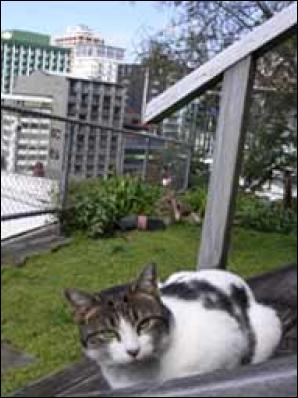Predator Cat Unwitting Wildlife Saviour
Predator unwitting wildlife saviour
Over the past year they’ve collected more than 30 skinks that Trilly brought in to their apartment unharmed, “to show us how to hunt”. Some have been taken to Karori Wildlife Sanctuary and the couple obtained permission from the Department of Conservation to hold others in captivity pending a transfer to Matiu/Somes Island.

Trilly
Twenty-six skinks, caught by the cat, Kelly and another Wellington resident will be released onto the island on October 14, as a highlight of an event celebrating 25 years of restoration on the island.
Kelly admits that they haven’t managed to save all the skinks that Trilly has snared in the undergrowth outside their apartment, highlighting the threats posed by cats to native wildlife.
“We know that she has killed four or five. We keep bits of terracotta pots and jars outside and inside that the skinks can take refuge in if we’re not there for the cat to bring them to. We try and create safe areas in the garden for them.”

Lucky skink
DOC ranger Andrew Morrison said studies have shown that cats only bring back a small proportion of what they catch.
“In this case the skinks were exposed because of land clearance and were more vulnerable to cats. But this cat has been gentle which is lucky for us as we were looking for a source population of ornate skinks for the island.”
And lucky for the skinks, which will be able to co-exist with other reptiles and native species on Matiu/Somes Island without the worry of cats or other mammalian predators.
“I’m going to miss them because they’re so beautiful,” says Kelly. “But they’re going to a fabulous place and they’ll just love it.”
Once widespread throughout the North Island, ornate skinks are now restricted to small refuge habitats where they can shelter from introduced predators, stoats and rats and habitat clearing.
Mr Morrison said skinks, lizards or geckos rescued from cats should be kept in a box or darkened cage to recover overnight before being released back into the garden. Rocks, tiles, bricks can be used to provide them with a safe refuge.
DOC’s Wellington Conservancy is keen to hear from people who find forest or green geckos, both species of which are declining nationally due to habitat loss and predation by introduced species. Forest geckos can be recognised by the range of bark-like patterns in grey, brown and sometimes green for camouflage on their skin. The inside of the mouth and tongue is bright yellow to orange. Green geckos have bright green skin often marked by two rows of yellow cream to white blotches, and the inside of their mouth is blue.
Geckos have baggy, velvety skin and broad heads while skinks have shiny, tight-fitting skins and look like snakes with legs. They both eat insects and fruit.
Cat owners can help protect native wildlife by .-
• Having their cat neutered or spayed so they can't produce unwanted kittens. Responsible cat ownership means not breeding unwanted litters - cats should be neutered or spayed unless they want to raise kittens.• Keeping their cat well fed and providing moving toys for it to play with, so it is less inclined to chase native wildlife.
• Keeping their cat indoors overnight so nocturnal insects and lizards have free reign of the garden.
• Not dumping unwanted kittens and cats - either give them to the SPCA or ask a vet to put them down humanely.
• Considering not keeping a cat if they live near an area known for its wildlife.
Greater Wellington Regional Council is highlighting the danger that cats pose to native wildlife in its Be the Difference campaign. Find out more on the council’s Be the Difference website:
http://www.bethedifference.gw.govt.nz
ENDS


 Bill Bennett: Download Weekly - 100% claim lands One New Zealand in criminal court action
Bill Bennett: Download Weekly - 100% claim lands One New Zealand in criminal court action FSCL: Woman Scammed Out Of $25,000 After Job Offer On LinkedIn
FSCL: Woman Scammed Out Of $25,000 After Job Offer On LinkedIn NIWA: Cheers To Crustaceans - New Species Named After Welly Brewery
NIWA: Cheers To Crustaceans - New Species Named After Welly Brewery MBIE: Trans-Tasman Earth Observation Research Studies Confirmed
MBIE: Trans-Tasman Earth Observation Research Studies Confirmed NZ Association of Scientists: Royal Society Te Apārangi Governance Submissions Close - NZAS Submission
NZ Association of Scientists: Royal Society Te Apārangi Governance Submissions Close - NZAS Submission HortPlus: Project Aims To Improve Quality Of Weather Data In New Zealand
HortPlus: Project Aims To Improve Quality Of Weather Data In New Zealand



